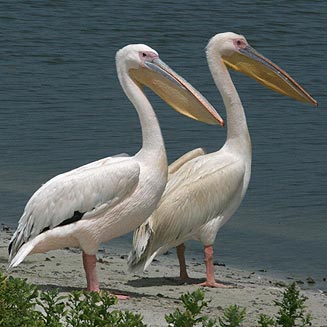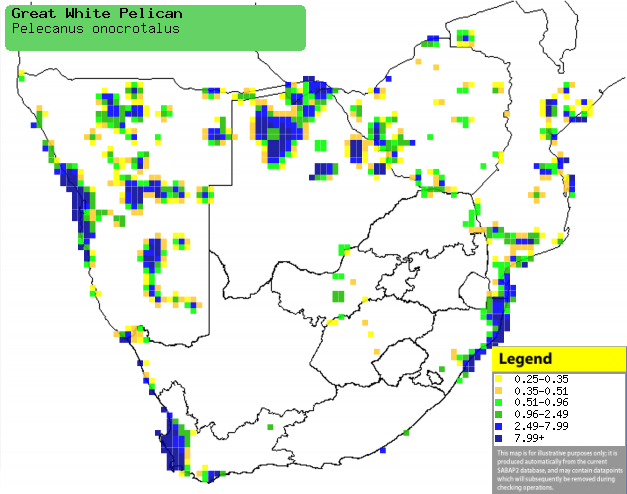|
Pelecanus onocrotalus (Great
white pelican)
Witpelikaan [Afrikaans];
Ingcwanguba [Xhosa]; iFuba, iVuba (generic terms for pelican), iKhungula,
[Zulu]; Gumbula, Khungulu, Manawavembe, Xilandzaminonga (generic terms for
pelican) [Tsonga]; Roze pelikaan [Dutch]; Pélican blanc [French]; Rosapelikan
[German]; Pelicano-branco [Portuguese]
Life
> Eukaryotes >
Opisthokonta
> Metazoa (animals) >
Bilateria >
Deuterostomia > Chordata >
Craniata > Vertebrata (vertebrates) > Gnathostomata (jawed
vertebrates) > Teleostomi (teleost fish) > Osteichthyes (bony fish) > Class:
Sarcopterygii (lobe-finned
fish) > Stegocephalia (terrestrial
vertebrates) > Tetrapoda
(four-legged vertebrates) > Reptiliomorpha > Amniota >
Reptilia (reptiles) >
Romeriida > Diapsida > Archosauromorpha > Archosauria >
Dinosauria
(dinosaurs) > Saurischia > Theropoda (bipedal predatory dinosaurs) >
Coelurosauria > Maniraptora > Aves
(birds) > Order: Ciconiiformes
>
Family: Pelecanidae
 |
 |
| Great white pelican, Strandfontein
Sewerage Works, Western Cape, South Africa. [photo
Duncan Robertson
©] |
Great white pelican, Rondevlei Nature Reserve,
Western Cape, South Africa. [photo Duncan Robertson
©] |
Distribution and habitat
Occupies patches of the Old World, from Vietnam to Greece
south to sub-Saharan Africa, largely absent from the lowland forest
of the DRC and West Africa. In southern Africa, it is locally fairly common in eastern and
southern Mozambique, Zimbabwe, the northern half of Botswana, Namibia and both
the far west and far east of South Africa. It generally prefers shallow lakes,
estuaries, flood plain pans, dams, sheltered coastal bays and lagoons.
|
 |
|
Distribution of Great white pelican in southern Africa,
based on statistical smoothing of the records from first SA Bird Atlas
Project (©
Animal Demography unit, University of
Cape Town; smoothing by Birgit Erni and Francesca Little). Colours range
from dark blue (most common) through to yellow (least common).
See here for the latest distribution
from the SABAP2. |
Predators and parasites
- Predators
- of adults
- of chicks and eggs
Movements and migrations
Resident, as it generally stays within 200-300
km of its breeding site, rarely travelling longer distances in
groups.
Food
It almost exclusively eats fish, foraging throughout the
day by itself or in a group, since by cooperating they can herd fish shoals
into shallow water. The large gular pouch beneath its bill is used to trap fish,
so that it can lift or jerk its head to swallow the prey item whole. It also
scavenges and kills animals while ashore, often working cooperatively to raid
other birds' nests of chicks and eggs. This behaviour appears to be taught from
one generation to the next, as in some colonies they do not do it at all. The following food items have been recorded
in its diet:
- Vertebrates
- fish
- Oreochromis mossambicus (Mozambique tilapia)
- Pseudocrenilabrus philander (Southern mouthbrooder)
- Barbus (barbs)
- Johnius (kobs)
- Terapon jarbua (Thornfish)
- Pomadasys commersonni (Elf)
- Sphyraena (barracuda)
- Mugil cephalus (Flathead mulllet)
- Labeo capensis (Mudfish)
- Argyrosomus hololepidotus (Kob)
- Schilbe intermedius (Silver catfish)
- Clarias gariepinus (Sharptooth catfish)
- Petrocephalus catostoma (Northern churchill)
- Tilapia (tilapia)
- Cyprinus carpio (Carp)
- Liza richardsonii (Southern mullet)
- Xenopus laevis (Common platanna)
- birds
- Other
- Caridina nilotica (freshwater shrimp)
- agricultural and chicken offal
Breeding
- Monogamous, although probably not faithful over multiple breeding seasons,
nesting in tightly packed colonies on the ground.
- The nest is built by the female with material provided by the male,
consisting of a scrape in the ground, excavated with repeated sideways sweep
of the mandible, lined with grass, sticks, reeds and feathers.
- Egg-laying season is sometimes year-round, peaking from
September-January in the Western Cape, June-August in Namibia and from
March-October in Botswana.
- It lays 1-3, usually 2 eggs, which are incubated by both sexes for 38-45
days in shifts of 1-3 days.
- The older chick pecks its younger sibling's head when the parents aren't
around, so only one chick fledges per brood. They are brooded by both
parents for the first three weeks of their lives, after which they form groups (known as
pods), taking their first flight at about 70-75 days old.
Threats
Not threatened globally, but Near-threatened in South
Africa, as its breeding attempts regularly fail due to human disturbance, such
as fishing activities and nest robbing.
References
-
Hockey PAR, Dean WRJ and Ryan PG 2005. Roberts
- Birds of southern Africa, VIIth ed. The Trustees of the John Voelcker
Bird Book Fund, Cape Town.
|
